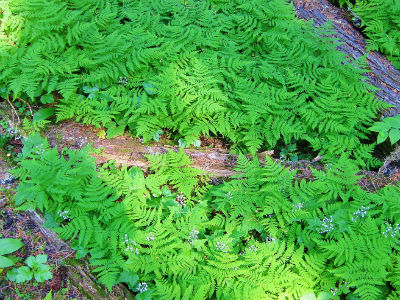but truly, as I live, all the earth shall be filled with the glory of the LORD Numbers 14:21
When I take the time to look around on my hikes, I almost always see something I haven’t seen before. Patterns of the most intricate kind abound in the woods and mountains as the above picture of ferns illustrates.
Ferns are non-flowering plants. Instead of flowers, ferns produce spores – lots of them. It is estimated that one fern can produce spores numbering into the billions during its lifetime. The spores are usually formed on the underside of the fronds, or what we may call the leaf of the fern.
Ferns play a role in what scientists refer to as ecological succession. A basic example of succession is the various plant species and communities that grow in any given area over a period of time. One instance of this which can be seen in the mountains where I live is what occurs after a wildfire burns though an area. Certain plants are especially efficient at growing on the resulting bare soil (providing the fire wasn’t so hot that it sterilized the soil). Then other plants come in and dominate the area for a time. This continues until a mature forest may result – sometimes years, decades, or even centuries after the fire. As you can see from the above picture, these ferns are in the process of breaking down woody material into simpler components of soil. This rich soil will later be used by plants larger than the ferns as this area returns back to a mature forest.
Perhaps you have seen ferns growing out of the face of a rock wall. Obviously, one of the spores from a fern landed on a bit of soil and took root. As the fern matures, its roots slowly break down the rock along with trapping minute bits of soil from the wind and air currents. As more soil is trapped and the fern matures, a seed from a larger plant such as a fir or pine may land on the soil and take root, resulting in a tree growing where one never grew before. It takes a while, but it is interesting to note the various stages of development going on around me on any particular hike.
Botany (the study of plants) was not my main field of education during my training or career, but it is an interesting area of study nonetheless. All of the various plant stages in ecological succession create a variety of habitat for a myriad of insect and animal life. Many ferns grow in moist areas, so below and among them there may be various types of earth worms, insects, and salamanders, etc. not found in other nearby regions. This in turn can attract birds and other critters which like to dine on these same worms and bugs.
You may not have a mountain or deep forest you can readily get to, but I’ve found a remarkable pattern of life right in my own backyard as well. Give it a close look sometime and I think you’ll be surprised.
What an amazing Creator.
Hope you have a great day.


 Hummingbird I
Hummingbird I
Leave a Reply